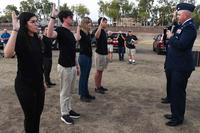Once you start getting the hang of stationary drill commands, your training instructor will take your unit to the next level and have you march. (You march everywhere you go in basic training.)
When performing marching drill, the preparatory command and the command of execution are given as the foot in the direction of the turn strikes the ground. For single formations, the preparatory command is given normally as the heel of the left (or right) foot strikes the ground, and the command of execution is given when the heel of the left (right) foot next strikes the ground.
For multiple units, time is allowed for the subordinate commanders to give appropriate supplementary commands. The pause between commands is three paces.
Remember: When executed from a halt, all steps and marching begin with the left foot.
Forward March
To march forward from a halt, the command of execution is, "Forward, march." On the command "March," you smartly step off straight ahead with your left foot, taking a 30-inch step (measured from heel to heel), and place the heel on the ground first. When stepping off and while marching, you will use a coordinated arm swing -- that is, right arm forward with the left leg and left arm forward with the right leg. The hands are cupped with the thumbs pointed down, and the arms hang straight, but not stiff, and swing naturally. The swing of the arms measures nine inches to the front (measured from the rear of the hand to the front of the thigh) and six inches to the rear (measured from the front of the hand to the back of the thigh).
To halt from marching, the command is "Halt," given as either foot strikes the ground. On the command "Halt," you will take one more 30-inch step. Next, the trailing foot is brought smartly alongside your front foot. The heels are together, on line and form a 45-degree angle. A coordinated arm swing ceases as the weight of the body shifts to the leading foot when halting.
Mark Time
Mark time is basically marching in place (without moving forward). The command is, "Mark time, march." When marching, the command of execution "March," is given as either foot strikes the ground. You take one more 30-inch step with the right (or left) foot. You then bring your trailing foot to a position so that both heels are on line. The cadence is continued by alternately raising and lowering each foot. The balls of the feet are raised two inches above the ground. A normal arm swing is maintained.
At a halt, on the command of execution "March," you raise and lower first the left foot and then the right. The halt executed from mark time is similar to the halt from forward march.
To resume marching, the command "Forward, march" is given as the heel of the left foot strikes the ground. You then take one more step in place and then step off in a full 30-inch step with the left foot.
Half Step
The command "Half step, march" is given as either foot strikes the ground. On the command "March," you take one more 30-inch step, followed by a 15-inch step (measured from heel to heel) in quick time (double normal marching speed), setting your heel down first without scraping the ground. Make sure that you maintain a coordinated arm swing and continue the half step until marching forward or halted.
Column Right (Left), March
This movement can be rather confusing to read about, but trust me: With a few minutes of practice with your drill instructor, you'll be turning as a group in no time.
To keep confusion to a minimum, I describe the movement to the right. Turning the left is the same (just exactly opposite).
On the command "Column right, march," the fourth element leader (the person in front of the far-right line of troops) takes one more 30-inch step, pivots 90 degrees to the right on the ball of the left foot and suspends arm swing during the pivot. After the pivot, step off in a 30-inch step and resume a coordinated arm swing. Beginning with the second step after the pivot, take up the half step. Each succeeding member of the fourth element marches to the approximate pivot point established by the person in front of her and performs the same procedures as the element leader (lead person).
The third element leader (the person to the immediate left of the fourth element leader) takes one 30-inch step (maintaining a coordinated arm swing throughout), pivots 45 degrees to the right on the ball of the left foot and takes two 30-inch steps before pivoting 45 degrees to the right on the ball of the left foot. Continue marching in 30-inch steps until even with the fourth element leader. Then begin half-stepping and establish interval and dress (alignment). Each succeeding member of the third element marches to the approximate pivot point established by the person in front of them and performs the same procedures as the element leader.
The second person (the person to the immediate left of the third element leader) takes one more 30-inch step (maintaining a coordinated arm swing throughout), pivots 45 degrees to the right on the ball of the left foot and takes four 30-inch steps before pivoting 45 degrees to the right on the ball of the left foot. Continue marching in 30-inch steps until even with the person who marches on the right. Then begin half-stepping and establish interval and dress. Each succeeding member of the second element marches to the approximate pivot point established by the person in front of them and performs the same procedures as the element leader.
The first element leader (the person in front of the far-left line of troops) takes one more 30-inch step (maintaining a coordinated arm swing throughout), pivots 45 degrees to the right on the ball of the left foot and takes six 30-inch steps before pivoting 45 degrees to the right on the ball of the left foot. Continue marching in 30-inch steps until even with the person who marches on the right. Then begin half-stepping and establish interval and dress. Each succeeding member of the first element marches to the approximate point established by the person in front of them and performs the same procedures as the element leader.
Once the entire formation has changed direction and dress, cover, interval and distance are reestablished, "Forward, march" is given. On the command "March," take one more 12-inch step with the right foot and then step off with a full 30-inch step with the left foot. When performing column left, the responsibility of dress reverts to the left flank on the preparatory command "Column left."
To the Rear, March
The command "To the rear, march" is given as the heel of the right foot strikes the ground. On the command of execution "March," you take a 12-inch step with the left foot, placing it in front of and in line with the right foot and distributing the weight of the body on the balls of both feet. Pivot on the balls of both feet, turning 180 degrees to the right and take a 12-inch step with the left foot in the new direction, with a coordinated arm swing. Then take a full 30-inch step with the right foot. While pivoting, do not force the body up or lean forward. The pivot takes a full count, and the arm swing is suspended to the sides as the weight of the body comes forward while executing the pivot, as if at the position of attention.
Change Step
The command is "Change step, march." On the command "March," given as the right foot strikes the ground, you take one more 30-inch step with the left foot. Then in one count, place the ball of the right foot alongside the heel of the left foot, suspend the arm swing and shift the weight of the body to the right foot. Step off with the left foot in a 30-inch step, resuming a coordinated arm swing. The upper portion of the body remains at the position of attention throughout.
Tip: Sometimes, when marching, you'll notice you're out of step with everyone else. A simple change step movement of your own will fix that.
Right (Left) Step
The command is "Right (left) step, march," given only from a halt and for moving short distances. On the command of execution "March," you raise your right (left) leg from the hip just high enough to clear the ground. The leg will be bent naturally, and not stiff, throughout the movement. You place the right (left) foot 15 inches, as measured from the inside of the heels, to the right (left) of the left (right) foot. Transfer the weight of the body to the right (left) foot and then bring the left (right) foot (without scraping the ground) smartly to a position alongside the right (left) foot as in the position of attention. The upper portion of the body remains at attention, and arms remain at the sides throughout.
Cadence may be counted during this movement. Counts 1 and 3 are given as the right (left) foot strikes the ground. Counts 2 and 4 are given as the heels come together.
To halt from the right (left) step, the preparatory command and command of execution are given as the heels come together. The halt from the right (left) step is executed in two counts. On the command "Halt," one more step is taken with the right (left) foot, and the left (right) foot is placed smartly alongside the right (left) foot as in the position of attention.
Right (Left) Flank
The command is "Right (left) flank, march," given as the heel of the right (left) foot strikes the ground. On the command of execution "March," you take one more 30-inch step and pivot 90 degrees on the ball of the lead foot, keeping the upper portion of the body at the position of attention. Then step off with the right (left) foot in the new direction of march with a full 30-inch step and a coordinated arm swing. The arm swing is suspended to the sides as the weight of the body comes forward on the pivot foot. The pivot and step-off are executed in one count. This movement is used for a quick movement to the right or left for short distances only. Throughout the movement, maintain proper dress, cover, interval and distance.
From Basic Training for Dummies, copyright © 2011 by Wiley Publishing, Inc., Hoboken, New Jersey. Used by arrangement with John Wiley & Sons, Inc.
Interested in Joining the Military?
We can put you in touch with recruiters from the different military branches. Learn about the benefits of serving your country, paying for school, military career paths and more: sign up now and hear from a recruiter near you.













